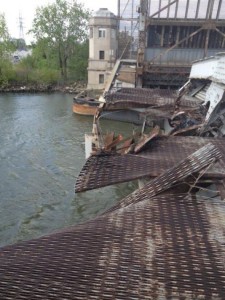During a recent nostalgia visit to my hometown with family members, a huge orange sign greeted us at the main intersection. It demanded that the bridge, which connects the small city with Detroit, be fixed! The message was aimed at the Wayne County government, which includes Detroit and a lot of small cities like my hometown.
The people, who have stubbornly held on to their homes while Detroit and their small city were depopulating, finally lost patience. The drawbridge was seriously damaged when an operator closed it on a passing 690-foot Great Lakes freighter heading up the Rouge River to a Ford steel plant. The bridge has been out of commission 26 months now. And there is no end in sight since Wayne County, like Detroit, is nearly bankrupt. There are no funds for repairing the bridge.
For me, this is a powerful symbol of government dysfunction and the damage it does, especially to the poor and working classes. The closing has cause additional financial damage to an industrial corridor that had already been impacted by the financial and business collapse of the great city. My hometown had already lost two-thirds of its 20,000 population during my youth, and the loss of that tax base was noticeable everywhere. Now it has even lost its most direct access to downtown Detroit, which adds to the woe.
But the tale of the biggest collapse of a major city (Detroit) in our nation’s history is really a tale of two collapses, the collapse of the city of man and the simultaneous collapse of the City of God, the Catholic Church in Detroit. The symbol of that latter collapse could also be seen in my hometown where the parish I grew up in is no longer. The beautiful gothic Church is gone. It was torn down and replaced with a smaller, ugly modern building to serve an ever-dwindling Catholic population. And even that is now closed after just a couple of decades.
When I was a school kid, the parish had a twelve-grade school, 1,000 children from working-class families. It too is gone; smaller numbers of Catholic families with fewer children spelled its doom. This population decline was partially caused by declining fortunes, but it was also caused by erosion of the Catholic faith and the notion of the family – both casualties of the post-Vatican II progressive administration of the Archdiocese of Detroit.
Prior to Vatican II, the Detroit Archdiocese had a population of about 1.3 million, half living in the city of Detroit. Today, the archdiocese has a little over 1.5 million, with only 86,000 living in the city. Just prior to Vatican II, the Archdiocese had close to 300 elementary schools and close to 100 high schools, about 70 of which were parish high schools like mine. Today, the whole archdiocese has 75 elementary schools and only 24 high schools.
In 1963, the Archdiocese operated three seminaries with over 800 seminarians, about 80 percent of whom were studying for Detroit. Today, there’s one seminary with approximately 100 students, which is substantially up from just a decade ago. When the city of Detroit was collapsing, the Archdiocese of Detroit was having a similar experience.

What happened? Well, most of this decline was set in motion during the age of Dearden, that is, during the reign of the Cardinal who was also the first president of the National Conference of Catholic Bishops (1966-71). Archbishop John Francis Dearden reigned in Detroit from 1958 to 1980, and all the seeds of its current ecclesial situation were sown during his episcopacy.
He went to the Second Vatican Council with the reputation of a conservative authoritarian. He returned as a liberal “consensus” leader. He was one of the two archbishops who favored birth control, and voted with the dissenting majority on the Birth Control Commission.
Upon his return to Detroit, he immediately set in motion a reeducation program for his clergy, bringing in American and European progressive and dissident theologians to give mandatory workshops for clergy. He eliminated any substantial opposition by allowing older priests [the recalcitrant] to retire at 65, and many of them, perhaps understanding what was about to happen, took the offer.
The cardinal also revamped the major seminaries with handpicked progressives and promoted cronies, such as the future Bishop of Saginaw, Kenneth Untener, who was named Rector of the Provincial Theologate at 41. Untener was an open dissenter on birth control. The rest is history. Catholics would rarely even hear the Church’s teaching on such matters, and Catholic family size went into predictable decline.
And then there was the near bankrupting of the Archdiocese by Cardinal Adam Maida, who (because of some sort of misguided Polish pride) got the archdiocese on the hook for $40 million to build the now failed John Paul II Cultural Center in Washington DC . The Knights of Columbus partially bailed out the Archdiocese in 2011 by purchasing the center for $23 million, but the present archbishop still has a burdensome debt. The Catholic Church in Detroit, clergy and laity, was always a fervent ally of the Democratic Party in Michigan, and borrowing without the ability to pay back loans seems to have rubbed off on the Church.
The schools that remain open are largely in affluent areas, but in cities like my own hometown – that is, in working-class cities – they mostly no longer exist. When government is irresponsible and dysfunctional, it’s always the poor who suffer most. When the Archdiocese failed to uphold the teachings on birth control and family, it was really undoing the Catholic school system, seminaries, and vocations. And in the end, it contributed to the decline of the city as well.
The empty spaces where my parish church and school once existed are an awful lot like the mass of empty spaces in the city of Detroit, symbols of decay. They fill me with sorrow. I want to put up my own sign: Fix the Darn Thing.















